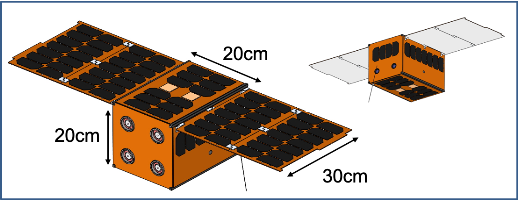| Satellite name | HORYU-VI (HORYU-6) |
|---|---|
| Form factor | CubeSat |
| Units or mass | 6U |
| Status | not launched, expected in 2025 |
| Launcher | not launched |
| Organization | Kyushu Institute of Technology |
| Institution | University |
| Entity | Academic / Education |
| Nation | Japan |
| Partners | Nanyang Technological University, Sapienza University of Rome, Kyushu Institute of Technology, Aliena, California Polytechnic State University (Cal Poly) |
| Oneliner |
Specialized in lunar horizon glow (LHG) |
| Description |
Interaction with the solar wind and UV/X-ray irradiation can cause the lunar dust to be electrostatically charged and mobilized all around the Moon, and light scattering by this dust cloud can be observed over the lunar terminator. This phenomenon, which has also been called the lunar horizon glow (LHG), still remains unexplained. The LHG observations using conventional lunar probes have limited observation opportunities and do not cover varying space weather conditions in cislunar environment such as strong upstream plasma flow and micrometeoroid flux that could enhance the lunar dust presence in the exosphere. The nanosatellite “HORYU-6” specialized in LHG observations will be put into lunar orbit to detect the light scattering above the lunar terminator. The proposed payload will perform multi-spectral imaging to monitor the lunar horizon several minutes before orbital sunrise or after orbital sunset for light scattering analysis. We show that we can obtain scientific results of lunar and planetary exploration using CubeSat at low cost and in a short period of time, and contribute to the development of lunar and planetary exploration in the future. The mission is proposed as a joint project among four countries, Japan, Singapore, Italy and United Sates. The mission objective is to detect the forward-scattering of the sunlight sunlight by the lunar dust population in order to monitor the variation of the dust cloud above the lunar terminator. By having a low-cost spacecraft dedicated to a single mission, we can drastically increase the amount of observation data. There are various technical issues to achieve the missions, such as propulsion, navigation and tracking, trajectory, communication, attitude control, and others. The paper addressed some of the key issues and demonstrated that the mission by a 12U CubeSat is feasible although still significantly challenging. Unfortunately, NASA recently announced that there will be no CubeSat payload on board Artemis-2 mission. Therefore, we have to find another opportunity to put the spacecraft into the lunar orbit. We believe that there are still chances, as long as the Artemis program continues and the program is supported by international partners. The HORYU-VI project continues to prepare for the future opportunity. |
| Sources | [1] [2] |
| Photo sources | [1] |
| Subsystems sources | [1] |
Last modified: 2024-12-09

